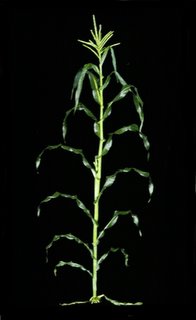The Enemy of My Enemy is My Friend.
| This maxim holds true in most parts of the world, including the plant and animal kingdoms. One of the really fascinating things about biology is the complex relationships that organisms develop with their environment, including the neighboring organisms with whom they share a common habitat. Lest you think I’m engaging in anthropomorphism applying this saying to organisms other than humans consider the relationship between Spodoptera littoralis,  Cotesia marginiventris, and Zea mays.   In my opinion, that saying is a perfect summary of their relationship. Spodoptera littoralis is a pest of many plants including corn. Adult females like the one pictured above lay their eggs on a wide variety of plants. When the larvae emerge they begin eating the host plant that their mother has chosen to be their meal. Plants being sessile, insentient, and generally lazy for that matter ;-) can do nothing to stop the attack by the hungry larvae and are eaten alive! Oh, the horror! But, remember, plants have been on this planet for a mighty long time. And they wouldn't have lasted this long without a trick or two up their sleaves. One of those tricks is the production of secondary metabolites that can do a range of things such as make them taste bad to their insect attackers (not something we want to encourage in our crop plants), or those secondary metabolites can serve as a signal to other organisms that: "dinner is served". When corn plants are eaten by lepidopteran larvae (moth and butterfly catterpillars), they release a complex mixture of volatile compounds. These compounds attract the adult females of parasitic wasp species such as C. marginiventris.  These parasitic wasps attack the larvae and lay a single egg in the posterior of the catterpillar. These parasitic wasps attack the larvae and lay a single egg in the posterior of the catterpillar.When the wasp egg hatches, the wasp larvae burrows inside the caterpillar's body and begins to chow down on the tasty parts inside. After the wasp larvae has eaten its fill, it burrows out of the caterpillar and forms a coccoon attached securely to the caterpillar's back,  in which the wasp will pupate. in which the wasp will pupate.This takes about 7 to 10 days for C. marginiventris. As you can see, the whole process leaves the caterpillar somewhat worse for wear.   This exit hole only tells part of the caterpillar's the tale of woe. Most of its internal organs have been eaten by the wasp and it will die in one day. Now, scientists have identified the particular compound that attracts this wasp to corn plants that are being attacked by insect herbivores. And they have identified the single gene in corn that is responsible for producing this chemical distress signal, or dinner invitation depending on your point of view! The gene is a terpene synthase gene, tps10, which produces "(E)- Interstingly, response to the sesquiterpenes produced by TPS10 appears to be a learned behavior in C. marniventris: Indeed, females of this species are initially not attracted to these typical induced plant signals (18) but appear to exploit them as host location cues only after associating them with the presence of hosts during an initial oviposition event (19, 20). |

